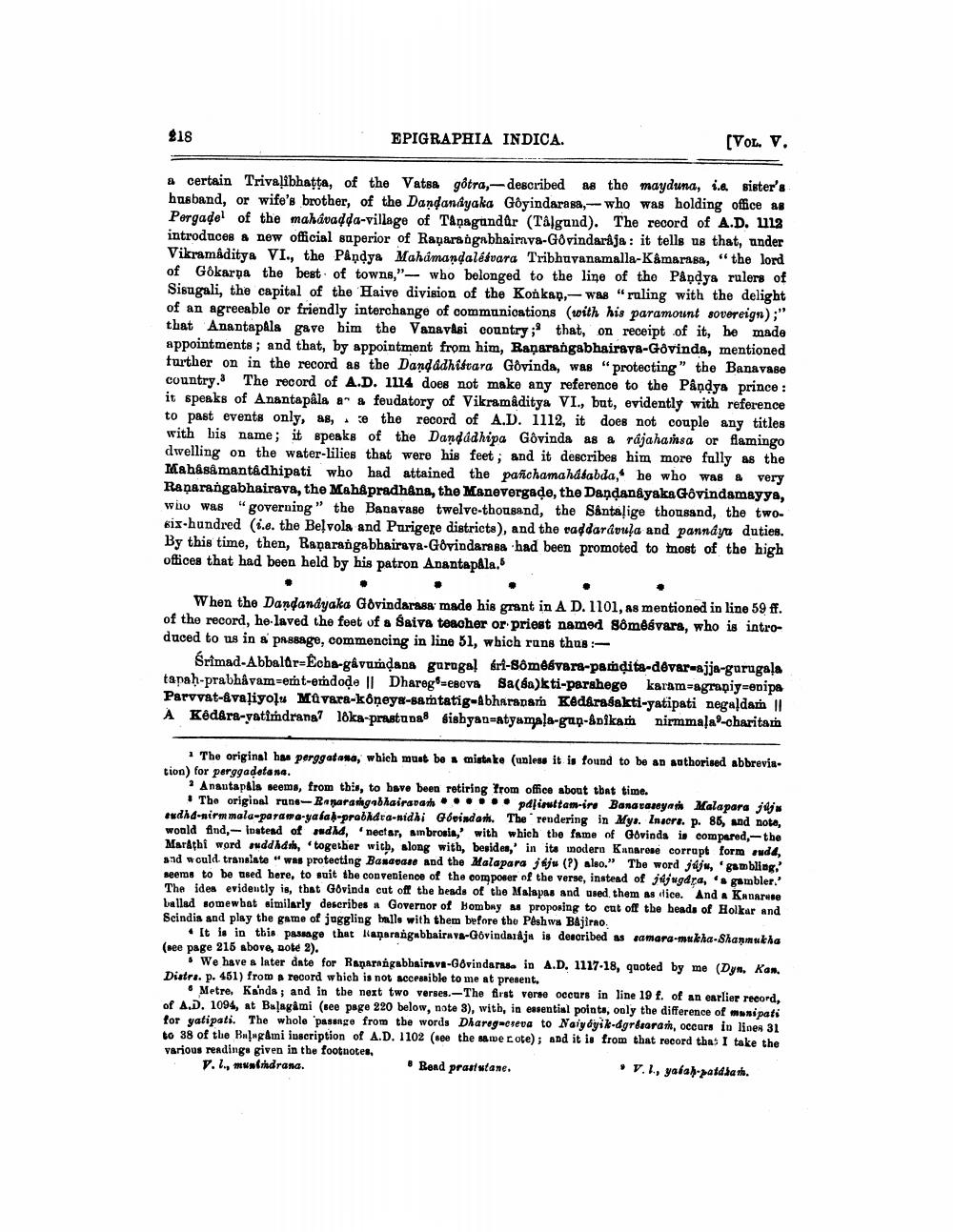________________
818
EPIGRAPHIA INDICA.
(VOL. V.
a certain Trivaļibhatta, of the Vatsa gôtra,- described as the mayduna, s.c. sister's husband, or wife's brother, of the Dandanayaka Gôyindarasa, who was holding office as Pergadel of the mahavadda-village of Taņagandür (Talgund). The record of A.D. 1112 introduces a new official superior of Ranara ngabhairnva-Govindaraja : it tells us that, under Vikramaditya VI., the Påndya Mahamandalesvara Tribhuvanamalla-Kámarasa, “the lord of Gokarpa the best of towns," — who belonged to the line of the Påndys rulers of Sisugali, the capital of the Haive division of the Końkan,- was "ruling with the delight of an agreeable or friendly interchange of communications (with his paramount sovereign);" that Anantapala gave him the Vanavasi country;' that, on receipt of it, he made appointments; and that, by appointment from him, Raņarangabhairava-Govinda, mentioned further on in the record as the Dandadhiftara Govinda, was "protecting" the Banavase country. The record of A.D. 1114 does not make any reference to the Påndya prince: it speaks of Anantapala a" & feudatory of Vikramaditya VI., but, evidently with reference to past events only, as, se the record of A.D. 1112, it does not couple any titles with his name; it speaks of the Dandadhipa Govinda as a rájahamsa or flamingo dwelling on the water-lilies that were his feet, and it describes him more fully as the Mahasamantadhipati who had attained the pafchamahdsabda, he who was a very Raņarangabhairava, the Mahapradhana, the Manevergade, the Dandanayaka Govindamayya, who was "governing” the Banarase twelve-thousand, the Santalige thousand, the twobis-hundred (i.e. the Belvola and Purigere districts), and the vaddarávula and pannaya duties. By this time, then, Ranarangabhairava-Govindarasa had been promoted to most of the high offices that had been held by his patron Anantapala.
When the Dandandyaka Govindarasa made his grant in A D. 1101, as mentioned in line 59 ff. of the record, he-laved the feet of a Saiva teacher or priest named Sômêsvara, who is introduced to us in a passage, commencing in line 51, which runs thus:
Srimad-Abbaltr-Écha-gávumdana garaga! 6r1-8ômêsvara-pamţita-devar-ajja-gurugala tapah-prabhavam=ert-emdode || Dhareg=eBCVS Sasa)kti-parshege karam=agrapiy=enipa Parvvat-dvaļiyols Mavara-koņeye-samtatig-Abharanam Kedarasakti-yatipati negaļdar || A Ked&ra-yatindrana? 18ka-prastada sishyan-atyamala-gap-&pikam nirmmala-charitam
1 The original has perggatana, which must be a mistake (unless it is found to be an authorised abbreviation) for perggadetana.
Anantapäls seems, from this, to have been retiring from office about tbat time.
• The original run-Ronarangabhairavarto..... pdfinultam-iro Banaranyat Malapara juju edha-nirmmala-parama-yalah-prabhdra-nidhi Govindan. The rendering in Mys. Ingers. p. 85, and nota, would find, instead of rudha, nectar, ambrosia,' with which the fame of Govinda is compared, the Marathi word suddhdth, together with, along with, besides,' in its modern Kanarese corrupt form rudd, and would translate" was protecting Basagase and the Malapara j tju (?) also." The word juju, gambling.' seems to be used here, to suit the convenience of the composer of the verse, instead of jingdra, 's gambler.' The idea evidently is, that Govinda cut off the beads of the Malapas and used them as dice. And a Kanarese ballad somewhat similarly describes # Governor of Bombay as proposing to cut off the heads of Holkar and Scindia and play the game of joggling balls with them before the Peshwa Bajirao
. It is in this passage that kaņarangabhairava-Govindaraju is described as samara-mukha-Shannukha (see page 216 above, note 2).
i We have a later date for Raparnagabhairava-Govindarase in A.D. 1117.18, quoted by me (Dyn, kan. Distrs. p. 451) from record which is not accessible to me at
• Metre. Kanda, and in the next two verses. The first verse occurs in line 19 f. of an earlier record, of A.D. 1094, at Balagami (see page 220 below, note 3), with, in essential points, oply the difference of usipati for yatipati. The whole passage from the words Dharegacreva to Naiydyik-dgrdaran, occurs in lines 31 to 38 of the Balag&mi inscription of A.D. 1102 (see the same cote); and it is from that record tha: I take the various rendings given in the footnotes, V. l., munirhdrana. * Bond prasutane.
. V. l, yaiah-padda.




